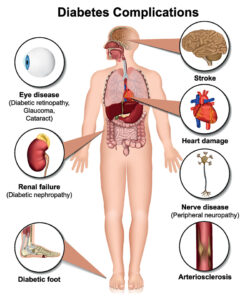Vascular Complications of Diabetes
The best way to reduce the chance of developing vascular disease is to work with your doctor to control your diabetes
By Eva Briggs, M.D.
 Diabetes affects about 38 million people in the U.S., more than one out of 10 adults. About 29% of people over 65 — about three out of 10 — have diabetes, many of whom are undiagnosed.
Diabetes affects about 38 million people in the U.S., more than one out of 10 adults. About 29% of people over 65 — about three out of 10 — have diabetes, many of whom are undiagnosed.
Diabetes damages blood vessels and causes many complications.
Vascular damage is divided into two groups. Microvascular disease involves small blood vessels in the eyes, kidneys and nerves. Macrovascular disease involves larger vessels of the heart, brain and peripheral blood vessels.
Here’s a description of each of these disorders.
Diabetic retinopathy occurs when the blood vessels supplying the retina are damaged. There are two main categories: non proliferative and proliferative. Non proliferative retinopathy damage includes: microaneurysms, bulging in tiny vessels where the wall is damaged and weakened; venous loops, where the damaged vessel stretches and loops, departing from its normal straight path; retinal hemorrhages, bleeding into the retina; exudates, deposition of substances that leak from damaged vessels.
In proliferative retinopathy, new blood vessels develop on the inner surface of the eye. These new abnormal vessels can bleed into the vitreous (the gel-like material filling the eye) or cause the retina to detach. This causes vision loss.
Diabetic retinopathy is extremely common, affecting nearly one in four persons with diabetes over the age of 40. The longer you have diabetes, the higher the risk. Between 4%-8% of retinopathy patients have severe vision-threatening disease. That’s why everyone with diabetes needs regular dilated eye exams. The goal is to identify and treat retinopathy to prevent blindness.
Diabetic nephropathy damages the small blood vessels in the kidney. The first sign is the loss of protein in the urine. High blood pressure increases the risk for diabetic nephropathy, and kidney damage increases the risk of high blood pressure. This is one reason for regular blood pressure checks and treatment of hypertension. Diabetes is the most common cause of end stage renal disease (kidney failure).
Neuropathy is the term for damaged nerves. Damage to sensory nerves can lead to numbness, tingling or burning pain. It’s most common in the feet. Because damaged nerves fail to register pain, small injuries can progress to ulcers and infection. In the worst scenario, diabetic patients with peripheral neuropathy require amputations.
Diabetic neuropathy can also affect the autonomic nerves that control various internal organs. Possible manifestations include gastroparesis (failure of the stomach to empty properly), constipation, diarrhea, bladder dysfunction, erectile dysfunction, and various heart problems.
Macrovascular disease damages larger blood vessels. Chronic inflammation in blood vessels leads to injury of the vessel walls, accumulation of plaque, and narrowing of the arteries that restricts blood flow. When the arteries that supply the heart, known as the coronary arteries, become narrowed, patients can suffer heart attacks. Damage to the arteries that supply the brain, the cerebral arteries, can lead to stroke. Diseased arteries in the legs and other body parts can lead to dysfunction or loss of limbs.
The best way to reduce the chance of developing vascular disease is to work with your doctor to control your diabetes. This includes not only medication, but also lifestyle choices for healthy eating, exercise — and not smoking.

